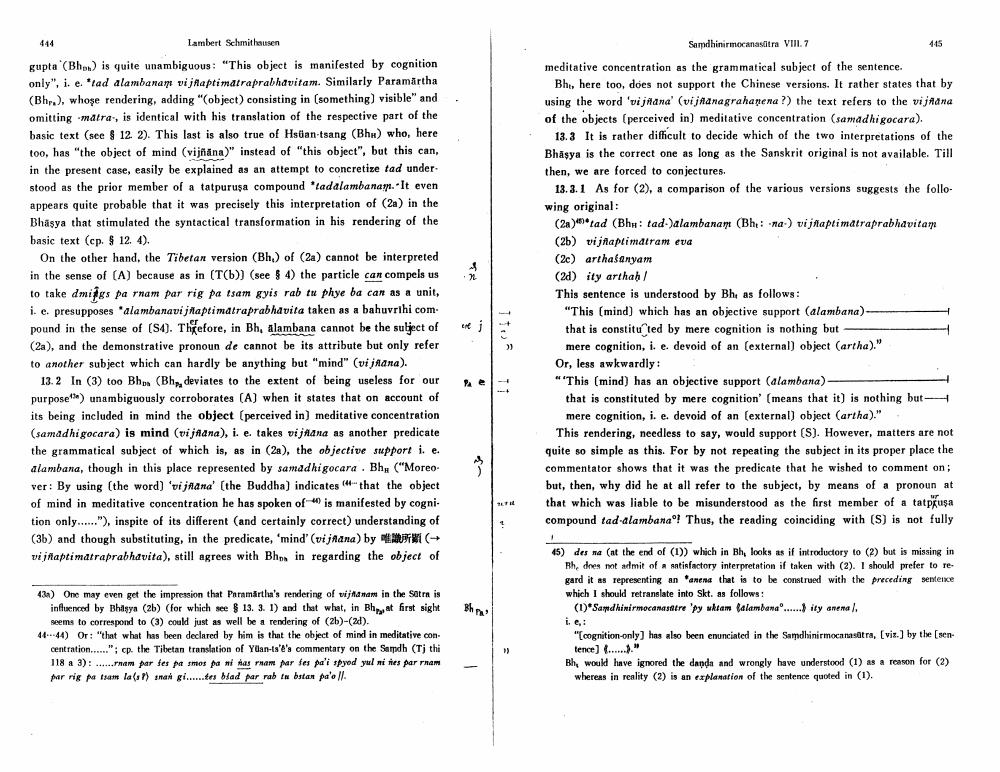Book Title: On Vinaptimatra Passage In Samadhinirmocanasutra VIII Author(s): L Schmithausen Publisher: L Schmithausen View full book textPage 7
________________ Samdhinirmocanastra VIII 7 415 . in Lambert Schmithausen gupta (Bhow) is quite unambiguous: "This object is manifested by cognition only", i. e. "lad alambana vijAlaptimatraprabhavitam. Similarly Paramartha (Bhr.), whose rendering, adding "Cobject) consisting in (something) visible" and omitting matras, is identical with his translation of the respective part of the basic text (see $ 12. 2). This last is also true of Hsüan tsang (Bhu) who, here too, has "the object of mind (vijnana)" instead of "this object", but this can, in the present case, easily be explained as an attempt to concretise tad under stood as the prior member of a tatpurusa compound tadalambana. It even appears quite probable that it was precisely this interpretation of (2a) in the Bhasya that stimulated the syntactical transformation in his rendering of the basic text (cp. $ 12. 4). On the other hand, the Tibetan version (Bh.) of (2) cannot be interpreted in the sense of (A) because as in (T(b)) (see $ 4) the particle can compels us to take dmijas pa rnam par rig pa sam gyis rab tu phye ba can as a unit, i. e. presupposes 'alambanavijflaptimatraprabhavita taken as a bahuvrihi com. pound in the sense of (S4). Thefore, in Bh, alambana cannot be the sulject of (2a), and the demonstrative pronoun de cannot be its attribute but only refer to another subject which can hardly be anything but "mind" (vijnana). 13.2 In (3) too Bho (Bhdeviates to the extent of being useless for our purpose) unambiguously corroborates (A) when it states that on account of its being included in mind the object (perceived in) meditative concentration (samadhi gocara) is mind (vijnana), i. e. takes vijnana as another predicate the grammatical subject of which is, as in (2a), the objective support i. e. alambana, though in this place represented by samadhi gocara. Bhy ("Moreo ver: By using the word) 'vijnana' (the Buddha) indicates that the object of mind in meditative concentration he has spoken of his manifested by cogni. tion only......"), inspite of its different and certainly correct) understanding of (3b) and though substituting, in the predicate, 'mind' (vijnana) by WI (+ vijnaptimatraprabhavita), still agrees with Bhon in regarding the object of meditative concentration as the grammatical subject of the sentence. Bh, here too, does not support the Chinese versions. It rather states that by using the word 'vijnana (vijnanagrahanena ?) the text refers to the vijana of the objects (perceived in) meditative concentration (samadhi gocara). 13.3 It is rather difficult to decide which of the two interpretations of the Bhasya is the correct one as long as the Sanskrit original is not available. Till then, we are forced to conjectures. 13.3.1 As for (2), a comparison of the various versions suggests the following original : (20)*tad (Bhy: tad-Salambanan (Bh: na vijnapti matraprabhavitam (2b) vijñaplimatram eva (2) arthasanyam (2d) ity arthah/ This sentence is understood by Bhe as follows: "This (mind) which has an objective support (alambana) - that is constituted by mere cognition is nothing butmere cognition, i. e devoid of an (external) object Cartha)." Or, less awkwardly: "'This (mind) has an objective support Calambana) - that is constituted by mere cognition' (means that it is nothing but mere cognition, i. e devoid of an external) object (artha)." This rendering, needless to say, would support (S). However, matters are not quite so simple as this. For by not repeating the subject in its proper place the commentator shows that it was the predicate that he wished to comment on; but, then, why did he at all refer to the subject, by means of a pronoun at that which was liable to be misunderstood as the first member of a tatusa compound tad-alambanao! Thus, the reading coinciding with (S) is not fully the il 11 11 Bh 431) One may even get the impression that Paramartha's rendering of wijnanam in the Satra is influenced by Bhasya (2b) (for which see $13. 3. I) and that what, in Bhat first sight seems to correspond to (3) could just as well be a rendering of (2b)-(d). 41-44) Or: "that what has been declared by him is that the object of mind in meditative con centration......"p. the Tibetan translation of Yuan-ta'e's commentary on the Sardh (Ti thi 118 a 3): ......rnam par fer pa smos pa mi das ruam par les pa'i pyod yul mi ties par ruam par rig pa sam la(s) shall gi......tes blad par rab ta bstan palo Il. 45) des na (at the end of (1)) which in Bh, looks as if introductory to (2) but is missing in Rh, dnes mot admit of antisfactory interpretation if taken with (2). I should prefer to regard it as representing an anene that is to be construed with the preceding senteixe which I should retranslate into Skt. as follows: (1)*Sandhinirmocanastre 'py wktam Balambana.......) ity anena i. , : "[cognition-only) has also been enunciated in the Samdhinirmocanastra, (vit. ) by the [sen tence] (.....)." Bh, would have ignored the danda and wrongly have understood (1) as a reason for (2) whereas in reality (2) is an explanation of the sentence quoted in (1).Page Navigation
1 ... 5 6 7 8 9 10 11 12
